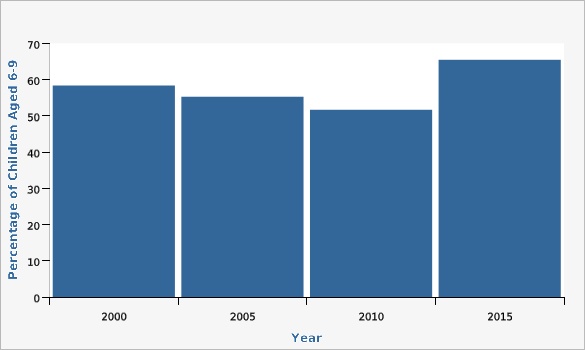Why Is This Important?
The Centers for Disease Control and Prevention [http://www.cdc.gov/healthywater/hygiene/disease/dental_caries.html (CDC)] says that dental caries (tooth decay) is '''''largely preventable''''', but it remains the '''''most common chronic disease of children''''' aged 6 to 11 years, and adolescents aged 12 to 19 years. '''''Tooth decay is four times more common than asthma''''' among adolescents aged 14 to 17 years. It is also one of the most preventable diseases. Oral health affects a person's overall general health.Percentage of Children Who Had Ever Had Dental Caries, Utah Children Aged 6-9, 2000-2015 |
Data Source
Utah Oral Health Survey, Utah Department of Health
Data Notes
It was planned to complete the next survey during the 2020-21 school year, but due to the COVID-19 pandemic, it was canceled. The date of the next survey is uncertain and depends on multiple factors including the length of the pandemic and future funding for the survey. ''2000 and 2005 data are for ages 6 to 8 years.''Risk Factors
Currently, only 52% of Utahns are drinking fluoridated water. Other risk factors include eating habits, such as frequent snacking and soft drink consumption, not brushing/flossing regularly, and not visiting the dentist regularly.How Are We Doing?
By first grade most children have already experienced dental disease, and by second grade one fifth have obvious untreated decay.
In a recent survey of parents of first through forth grade children, one in five (18%) did not have insurance that pays for dental care.What Is Being Done?
Community water fluoridation has been implemented in Salt Lake and Davis counties. It is also being implemented in Brigham City and Helper communities.Healthy People Objective: Reduce the proportion of children aged 6 to 9 years with dental caries experience in their primary and permanent teeth
U.S. Target: 49.0 percent
Date Indicator Content Last Updated: 10/26/2020

